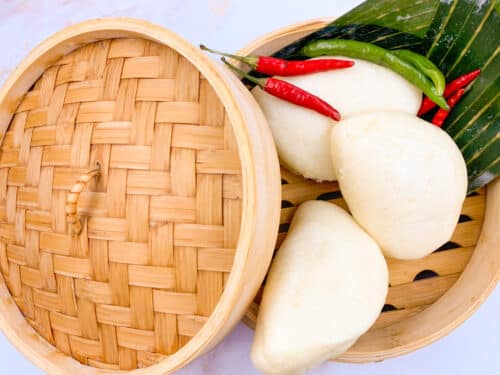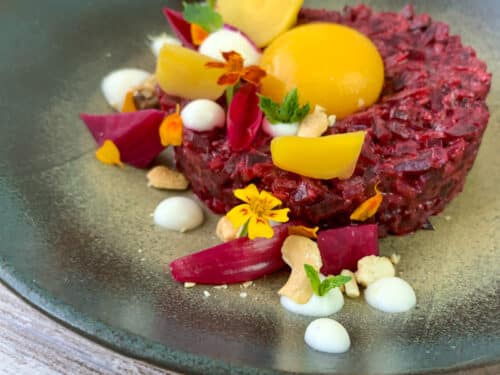What exactly is Creme Brulee?
Crème brûlée, meaning “burnt cream” in French, is a famous dessert, and the classic version is an enriched custard made of heavy cream, egg yolks, sugar, and vanilla. After the custard is cooled down it is sprinkled with sugar, which is burned under a broiler or with a kitchen blowtorch until caramelized, creating a hard layer on top of the creamy custard.
A perfect Creme Brulee is creamy, has a soft mouthfeel and the caramel layer has to crack when you dip your spoon in the custard. The custard base is traditionally flavored with vanilla but can have a variety of other flavorings including chocolate, orange liqueur, and fruit. In my recipe we are going to use lemongrass, which gives a nice fresh flavor to the cream.
This dessert is normally served slightly chilled; the heat from the caramelizing process tends to warm the custard, leaving a cold center.
Another classic French dessert. Try my Recipe for Chocolate Soufflé

The history of Creme Brulee
The exact origin of a dessert with enriched custard and a caramel crust is uncertain. France, England, and Spain all claim to be the country where this kind of dessert had its origin.
From the time of its invention in the 17th century until early in the 20th century, Creme Brulee was a stirred cream, prepared on the stove top. Only later the cooking in a water bath in the oven was adapted like in the modern versions.
Even if historical custards, enjoyed in medieval times, were not the same as the modern Creme Brulee, it’s easy to see how several countries could—independently of one another—create quite a similar dish and call it their own.
The first printed recipe for a dessert called crème brûlée is from the cookbook “Le Cuisinier Royal et Bourgeois” written by a famous French cook, Francois Massialot, who served as a cook to a variety of famous characters from the French high society including at the Palace of Versaille. His version was a sweet custard of egg yolks and milk with a burnt sugar crust, very similar to the modern versions.
In England, another version of Creme Brulee was served at Trinity College in Cambridge called “Burned Cream” or “Trinity Cream” which is still very famous today. The college crest was burnt into sugar on top of custard using a hot iron.
Another recipe of custard with a caramelized sugar crust originates in Catalonia and is called “Crema Catalana” in Spain. In Catalonia, this dessert is called “Crema Cremada” (burned cream), “Crema Casolana” or “Crema de Sant Josep”, because it used to be the typical dessert traditionally only eaten at St. Joseph’s Day. Nowadays it is very famous and consumed at all times of the year.
Crema Catalana is a little bit different from the classic Creme Brulee, as the cream is cooked not only with eggs but also with corn starch and due to this gets a slightly different texture.
Creme Brulee was not very common in French and English cookbooks of the nineteenth and twentieth centuries, but became again remarkably popular in the 1980s.
The largest Creme Brulee weighed 725.72 kg and was made by students at the Orlando Culinary Academy, Florida, in 2005.

Important facts to know about Custards
Technically speaking a Creme Brulee is a custard. This means it’s a liquid (milk or cream) that has been thickened or set via the coagulation of egg protein.
The custard family goes from Crème anglaise, Crème brûlée, Pastel de Natas, Cheesecakes, until Savoury quiches. Basically a mixture of eggs with liquid, the difference is only in the ratios.
To make a perfect Creme Brulee the temperature of the mixture of liquid and eggs must be kept below 85 °C. Above this temperature, the custard will start to curdle, resulting in a separation of the liquid and the egg protein and an unpleasant mouthfeel.
To understand Custards, you first have to understand some basics about the most important ingredient, the eggs and how temperature influences them.
Whole eggs begin to change at 60 °C and a soft gel forms around 75 °C.
Yolks begin to coagulate (the change in the structure of the proteins from liquid to a thicker or solid form ) at 65 °C and set firmly around 70 °C.
Egg whites in general start to coagulate and change their appearance at 58 °C to 60 °C. Around 65 °C they stop flowing and are firm and fully set at 82 °C.
As in the case of custards, when eggs are diluted, the coagulation temperature increases. A Custard made with whole eggs or yolks is fully set between 82 °C and 85 °C. Beyond 85 °C and the mixture will begin to curdle.

Some Tipps to make the perfect Creme Brulee
Why the Water bath? – As you have read above temperature is the main influencer in custards and diluted eggs have specific temperatures to coagulate. The changes can happen quickly as the temperature increases, this is why custards are often baked at lower temperatures and in water baths, to prevent overcooking. It is not advisable to cover the whole water bath, since this forces the water to a boil, making it more likely to be overcooked.
Always add hot ingredients to cold – Most custards are made by heating the liquid to the boil, and then gradually stirring it into the egg and sugar mixture to heat up the eggs. This technique gently heats up the mixture, bringing the eggs just shortly before setting temperature. Adding cold eggs into the hot liquid would immediately heat up the first parts of egg close to boiling temperature, basically creating scrambled eggs.
Eliminate the bubbles – When you pour the finished mixture inside your ramekins or forms to bake the Creme Brulee in the oven, a lot of times some bubbles form on top. Just take a bit of paper and tip one edge into the bubbles, making them disappear. Like this, the Creme Brulee gets a nice and more even surface. Another way is to quickly flash the top with a blowtorch to remove them.
Let the Creme Brulee cool down – Before caramelizing the top, make sure to let the Creme Brulee cool down and chill at least for 4 hours or overnight, so you don’t overcook the custard when heating the surface in the caramelization process. If you don’t have so much time, let the forms cool down at room temperature, and then place them in the freezer for 20 minutes before caramelizing the tops.
When is my Creme Brulee done? – Well first you can just follow my recipe and everything is going to be fine, but there are a few ways to find out for yourself. You can probe the interior with a toothpick or a knife, which should return without anything sticking to it. Also, when you move the forms around or bump them, they should be firm, but still with some visible jiggle in the center. You can also check if your Creme Brulee is done, by checking the internal temperature. When the mixture reaches 77 °C to 79 °C, it’s time to take out the forms from the oven. They will continue cooking when cooling down at room temperature and set about 82 °C.
Recipe for Creme Brulee with Lemongrass
Equipment
- 4 ramekins
- deep oven tray
- whisk
- pot
- fine sieve
- kitchen scale
- kitchen torch
Ingredients
- 250 g milk
- 250 g cream
- 100 g granulated sugar
- 4 egg yolks
- 1/2 vanilla bean
- 60 g lemongrass
Instructions
- Cut the vanilla bean and the lemongrass into small pieces.
- In a saucepan, add the milk, the cream, the lemongrass and the vanilla bean. Bring to a boil, and as soon as it boils, remove from heat.
- Let it infuse for 30 minutes.
- Preheat the oven to 130 °C.
- Heat the mixture again until it boils, remove from heat.
- In a bowl, mix the yolks with the sugar with a whisk. Just mix until incorporated, do not beat.
- Now slowly add 1/4 of the liquid to the mixture of yolks and sugar, while constantly stirring with the whisk. Then gradually add the rest of the liquid. Mix all ingredients well.
- Pass the mixture through a fine sieve to remove the pieces of vanilla and lemongrass.
- Put some water to a boil for the water bath (to cook in the oven).
- Fill the ramekins with the creme brulee mixture, and place in a deep baking tray. If you have some bubbles on the surface, you can remove them with the help of a little piece paper, or ignite them with a kitchen torch.
- First, place the deep tray with the ramekins in the oven and then carefully fill the tray with water to half the height of the ramekins. (Important, do not cover the tray)
- Bake the creme brulee at 130 °C for 40 minutes. You can see that the creme brulee is done, when you move the forms, and the mixture is firm, but still with some wobble visible in the center. You can also probe the interior with a toothpick or knife, which should return without anything sticking to it.
- Carefully remove the ramekins from the tray and let them cool down to room temperature. When at room temperature, cover with film and place in fridge. Refrigerate for at least 4 hours, or best overnight. If for some reason you don't have time to wait, place the ramekins in the freezer for 20 minutes to serve.
- Put some granulated sugar on the surface of each ramekin with creme brulee and heat to form the caramel, it is best to use a kitchen torch to give the caramel the ideal consistency.
- Let the hot caramel cool down a little, before serving.












